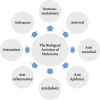Exploring the Phytochemical Compositions, Antioxidant Activity, and Nutritional Potentials of Edible and Medicinal Mushrooms
- PMID: 38841191
- PMCID: PMC11152763
- DOI: 10.1155/2024/6660423
Exploring the Phytochemical Compositions, Antioxidant Activity, and Nutritional Potentials of Edible and Medicinal Mushrooms
Abstract
Mushrooms are a valuable source of food and medicine that have been used for centuries in various cultures. They contain a variety of phytochemicals, such as terpenoids and polysaccharides, that exhibit diverse biological activities, such as antioxidant, anti-inflammatory, anticancer, antimicrobial, immunomodulatory, and antidiabetic effects. However, mushroom's phytochemical composition and bioactivity vary depending on their species, cultivation conditions, processing methods, and extraction techniques. Therefore, using reliable analytical methods and standardized protocols is important for systematically evaluating the quality and quantity of mushroom phytochemicals and their therapeutic potential. This review provides a bibliometric analysis of the recent literature on biological activities, highlights trends in the field, and highlights the countries and journals with the highest contribution. It also discusses the nutritional value of the total content of phenolic and other phytochemicals in some species of mushrooms.
Copyright © 2024 Mohammed Al Qutaibi and Suresh R. Kagne.
Conflict of interest statement
The authors declare that there are no conflicts of interest.
Figures





References
-
- Chang S. T., Wasser S. P. Oxford Research Encyclopedia of Environmental Science . 2017. The cultivation and environmental impact of mushrooms.
-
- Pavlovna V., Gordon Wasson R. MUSHROOMS RUSSIA AND HISTORY . 1957. http://www.NewAlexandria.org/
-
- Hawksworth D. L. The magnitude of fungal diversity: the 1.5 million species estimate revisited. Mycological Research . 2001;105(12):1422–1432. doi: 10.1017/s0953756201004725. - DOI
Publication types
LinkOut - more resources
Full Text Sources

